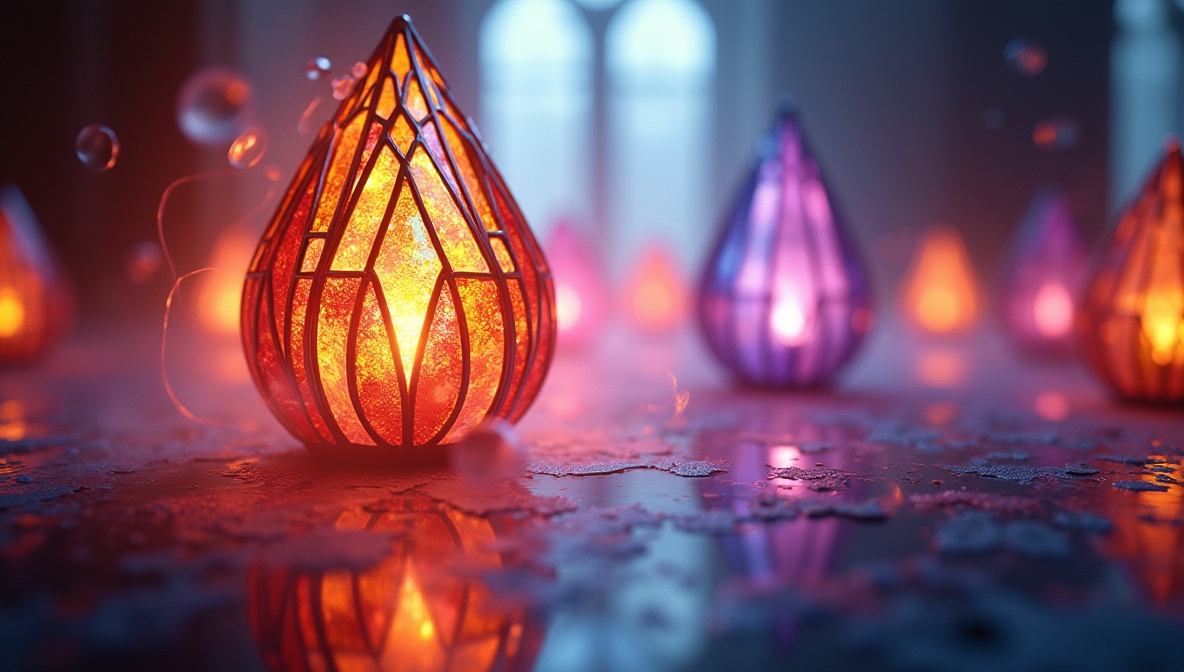Stained glass transforms ordinary light into a spectrum of vibrant hues, turning windows into intricate tapestries of storytelling and symbolism. This centuries-old craft continues to shape religious, cultural, and modern artistic landscapes, blending craftsmanship with imagination.
A Brief History of Stained Glass
Stained glass dates back to ancient Rome and Egypt, where artisans infused small pieces of colored glass into decorative mosaics. The craft flourished during the medieval period, with Gothic cathedrals showcasing elaborate biblical scenes. Over time, the technique evolved, extending beyond religious institutions into secular architecture and contemporary art.
Key Periods in Stained Glass Evolution
- Medieval Gothic (12th–16th Century) – Characterized by large, narrative-driven church windows. Rose windows, lancet windows, and intricate tracery became defining elements.
- Renaissance (16th–18th Century) – Artists shifted from bold outlines to more painterly techniques, focusing on perspective and realism.
- Victorian Era (19th Century) – Innovations in glass manufacturing allowed for richer colors and complex layering.
- Art Nouveau & Art Deco (Late 19th–Early 20th Century) – Organic forms and geometric patterns emerged, moving away from religious themes.
- Modern and Contemporary (20th Century–Present) – Stained glass extends into abstract compositions, corporate buildings, and public art installations.
How Stained Glass Is Made
The process of creating stained glass requires skill, precision, and an understanding of light dynamics.
1. Designing the Pattern
Artists create a full-scale drawing, or “cartoon,” outlining the shapes, colors, and lead lines. Each section represents a separate piece of glass.
2. Selecting and Cutting Glass
Sheets of colored glass are chosen for their hues, transparency, and texture. Artisans cut each piece using specialized tools, ensuring a precise fit within the design.
3. Painting and Staining
Details such as facial expressions and shading are applied using powdered pigments mixed with oil or water. The glass is then fired in a kiln to fuse the paint permanently.
4. Leading and Soldering
Pieces are joined together using H-shaped lead cames, which provide structure and flexibility. Solder is applied at the joints, securing the framework.
5. Cementing and Polishing
A cement-like putty is pressed into the gaps, adding stability and weatherproofing. Once dry, the surface is cleaned and polished for clarity.
Symbolism and Meaning in Stained Glass
Throughout history, stained glass has carried deep meanings, often reflecting religious, mythological, and cultural themes.
- Religious Iconography – Biblical figures, saints, and divine symbols dominate medieval church windows.
- Nature Motifs – Flowers, birds, and landscapes convey themes of growth, renewal, and harmony.
- Geometric Patterns – Abstract compositions emphasize balance, symmetry, and sacred geometry.
- Heraldic Symbols – Coats of arms and family crests reinforce lineage and status.
Famous Stained Glass Masterpieces
Several works stand as testaments to the enduring power of stained glass artistry.
Chartres Cathedral (France)
This Gothic landmark houses some of the finest medieval stained glass, with deep blues and intricate biblical storytelling.
Sainte-Chapelle (Paris, France)
Its towering windows bathe the chapel in a kaleidoscope of color, depicting over 1,000 biblical scenes.
York Minster (England)
The Great East Window, the largest medieval stained glass window in England, illustrates the Book of Revelation.
Tiffany Glass (United States)
Louis Comfort Tiffany revolutionized stained glass with opalescent glass techniques, producing lamps and window panels with unmatched depth and texture.
Modern Applications of Stained Glass
Beyond cathedrals and historic buildings, stained glass has found a place in contemporary spaces.
Residential Interiors
Homeowners incorporate stained glass in doors, skylights, and room dividers, adding elegance and color.
Public Art and Installations
Urban landscapes feature large-scale stained glass sculptures and interactive installations that play with light and movement.
Corporate and Commercial Spaces
Hotels, restaurants, and office buildings use stained glass to create dynamic visual statements.
Museum and Gallery Exhibits
Artists push the boundaries of traditional stained glass, blending it with mixed media and digital elements.
Preservation and Restoration
Maintaining stained glass requires specialized care to prevent deterioration from weather, pollution, and time.
Common Restoration Techniques
- Cleaning and Surface Repair – Removing grime and residue without damaging the original glass.
- Releading – Replacing deteriorated lead cames to restore structural integrity.
- Glass Replacement – Using historically accurate glass to repair missing or broken sections.
- Protective Glazing – Adding external glazing layers to shield windows from environmental damage.
Learning the Craft
Aspiring artisans can learn stained glass through workshops, online courses, and apprenticeships. Skills such as glass cutting, painting, and soldering require practice, but the results are rewarding.
Essential Tools and Materials
- Glass Cutter – For shaping individual pieces.
- Soldering Iron – Used to join lead cames.
- Kiln – Necessary for fusing painted details.
- Patina and Polish – Applied for aging effects and final finishing.
The Lasting Appeal of Stained Glass
Stained glass remains a dynamic form of artistic expression, blending craftsmanship with innovation. Its ability to manipulate light continues to inspire architects, designers, and artists across generations. Whether in grand cathedrals or contemporary installations, stained glass stands as a testament to creativity, skill, and the transformative power of color.



